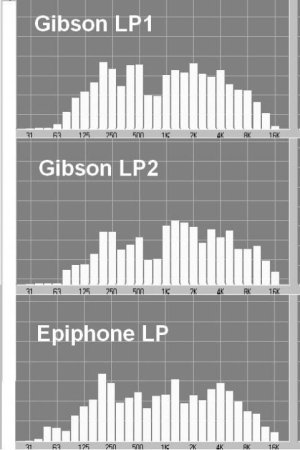Also since I'm asking about guitar tone it seems like everyone has there own definition of the different tone terms. I've heard some people describe fat as more mid heavy and others as more bass heavy. So like what do all these different term actually mean like thin, warm, flat, woofy, dark, tight, loose thick, airy etc....?
Tone-descriptive words mean totally different things to different people and there's no accepted standard at all.
Most of us seem to agree that brightness has to do with treble, but that's about all the consensus we've got.
It doesn't help that there's a lot of overlap between tone and feel - big lows can feel tight or loose.
I like loose vintagey lows in a pickup, but when they're too loose for a certain guitar I'd call them woofy.
And with too much gain, woofy can turn into tubby - which isn't always a bad quality, unless you need tight chug.
Again, though, that's as much about feel as sound.
My primary tone words:
I'd say fatness lives mostly in the low mids. Vowel tones (oooh, aaah, eee) make up the mid-mids. Snarl & cut are in the upper mids.
To me, presence lives mostly in the low treble, brightness in the middle treble, sparkle in the high treble, and air in the highest of highs.
For me, warmth means gentle or subdued highs, usually combined with rich mids.
Darkness refers to a lack of highs, and thinness speaks to a deficiency of lows & low mids.
I'd say thick is similar to fat, but involves a broad hump throughout the low mids and mids, rather than just a bump in the low mids.
There's another aspect of thickness and/or fatness when you play high up the neck. Not always the same as it is on the lower notes.
Those are just my personal word choices though, not well-defined terms; other players might assign completely different meanings.
Again, much of our vocabulary is about feel and tone both. Certain pickups have an especially fierce character.
Some pickups are said to be dry, others are described as juicy. Good P90s have bark.
I can't define those specifically, yet to me they convey meaning; I've come to associate those qualities with a certain sound and feel.
I had one pickup which in that particular guitar could only be described as scratchy. Not just bright and thin, but also harsh.
Some words have more than one accepted meaning when talking tone - ironically, definition is one of them.
We use it for a sharp pick attack that helps give articulation and precise timing to every note you play.
We also talk about string-to-string definition, where each individual note in a chord remains distinct from the others.
And there are descriptors for dynamic character; people talk about fast or vintage attack, and about bloom on sustained notes, or clean stops when playing power chords.
Words for texture get even more hard to nail down. To me, wooly is quite different from woofy. I've heard some pickups referred to as smooth, yet I've also heard that word in conjunction with the treble voicing on others. Gain can be smooth, or rough, or buzzy, or even grainy.
Sorry to have gotten so wordy here in the middle of the night. I get carried away sometimes.
My main point is, when we talk tone, we aren't usually talking just about sound.

